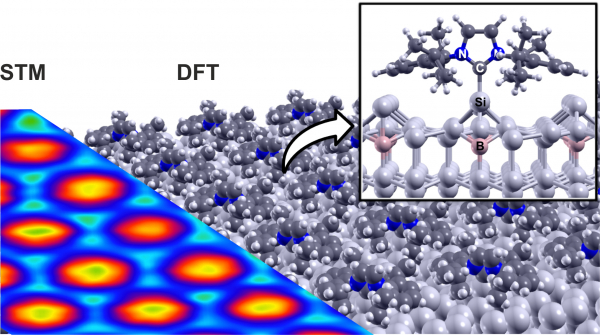An important challenge in materials research is to design and fabricate silicon-based materials with functional and tailorable surface properties. A promising bottom-up strategy for achieving this is through self-assembly of molecules. Although self-assembly is commonly harnessed to induce ordered growth on metal surfaces, the high reactivity of #semiconductors tends to inhibit it, as molecules tend to randomly stick where they land. In a new publication in the prestigious journal Nature Chemistry, an interdisciplinary collaboration of scientists including Dr Conor Hogan of the Institute of Structure of Matter (ISM-CNR) in Rome and groups in Berlin, Paderborn and Münster (Germany) have demonstrated that stable and well-ordered molecular single layers can be prepared on silicon by self-assembly of N-heterocyclic carbenes. These are highly reactive yet highly configurable #organic_molecules that have attracted much interest in recent years not least in relation to their use as surface ligands on metal surfaces such as gold and copper. While smaller #carbenes tend to form stable but disordered layers on silicon, the addition of side groups that slightly lift the molecules away from the surface grants them just enough mobility to form ordered islands and eventually larger epitaxially matched arrays. The mechanisms driving self-assembly were identified through a combination of organic synthesis, scanning tunneling microscopy, and photoemission spectroscopy, supported and interpreted by first principles atomistic simulations carried out in part at the CINECA supercomputing centre in Bologna. This multi-facetted approach allowed the scientific team to establish a set of guiding rules for driving ordered growth of a variety of molecules and surfaces, thus establishing a new paradigm for molecular #functionalization of surfaces with possible applications in photovoltaics, sensor technologies, and beyond.
Tuesday, 22 June 2021 09:55
A new paradigm for molecular assembly on semiconductor surfaces
 Small carbene molecules attach to silicon adatoms on a passivated Si(111) surface, forming an ordered molecular layer
Small carbene molecules attach to silicon adatoms on a passivated Si(111) surface, forming an ordered molecular layer
In a new publication in Nature Chemistry, an interdisciplinary collaboration including researchers from CNR-ISM have demonstrated a new paradigm for molecular #functionalizion of #semiconductor surfaces by preparing stable, ordered arrays of #organic_molecules on silicon. Using N-heterocyclic #carbenes with customized electronic and geometrical properties, the team have shown that self-assembled growth of single molecular layers can be achieved, opening up new possibilities in semiconductor technologies. #SAMs
Published in
Publications

 English (UK)
English (UK)  Italiano (Italia)
Italiano (Italia)